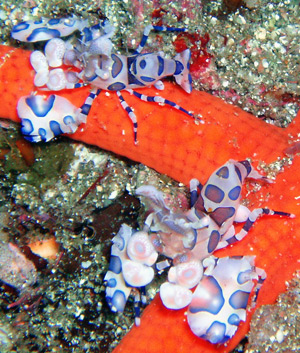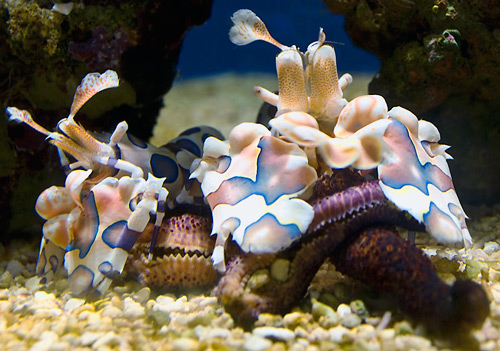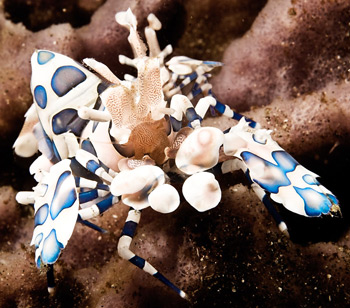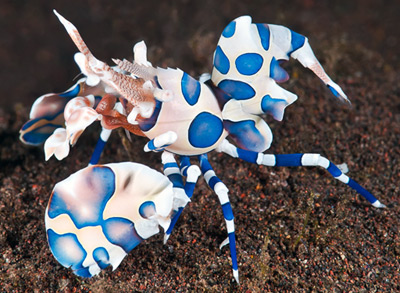Somewhat comical and cartoonish in both name and appearance, harlequin shrimps (Hymenocera picta) are not invertebrates to be purchased on a whim. Keeping these critters, as I’ll soon explain, demands an investment of cash and effort that not every marine aquarium hobbyist is willing to undertake. Not to mention, their very narrow feeding habits are not necessarily for the softhearted.
A quick note on taxonomy
Though here I’ll be referring to H. picta as the harlequin shrimp, be aware that some sources split these shrimps into more than one species. For example, you may come across references to H. elegans, and possibly others, in your research. I chose to stick with H. picta primarily to keep things simple and because that’s the only Hymenocera species recognized as valid in the Integrated Taxonomic Information System database.
Physical traits
H. picta is white to tan overall and dappled with large spots that can be various shades of pink, red, purple, or blue—hence the clownish common name. Its front claws are oversized and paddle-like (looking kind of like giant oven mitts, if you ask me), but its maximum size is only about 2 inches.
Feeding

Here’s where things get tricky. H. picta has a very specific diet limited to live starfish and potentially other echinoderms. I’ve read in some sources that they will accept frozen starfish as well, but I don’t know whether they can be sustained in good health long term with this food. There are also anecdotal accounts of specimens accepting other frozen food items, but I wouldn’t depend on that either (if any salties out there have more/better insights on feeding these shrimps substitute foods, please share them in the comment section below).
Hobbyists who keep these shrimps commonly feed them live chocolate chip starfish, which, as you might imagine, has the potential to get logistically challenging and prohibitively expensive for those of modest means. Some also keep several of these starfish in a separate system and “harvest” arms from them to be fed to the harlequins. If the stars are maintained under excellent conditions, the harvested arms soon regenerate. The little Asterina spp. starfish that sometimes plague reefkeepers’ tanks can be another food option if you can source a steady supply of them.
Of course, if feeding living things to other living things (or cutting off parts of living things to feed to other living things) presents an ethical dilemma for you, H. picta is probably not your best choice.

Housing
These little shrimps don’t demand considerable tank space. You can technically keep them in a tank as small as 10 gallons. However, their diet tends to produce a hefty amount of dissolved pollutants, so you can’t afford to get behind on those water changes if you want to keep them alive and happy in such a small system. Water quality must be stable and exceptional!
Tankmates

Harlequin shrimps are best kept as mated pairs in dedicated single-species tanks where their unique needs can be more easily met. Small, peaceful fishes that aren’t inclined to go after crustaceans can be suitable tankmates, but keep in mind that a lot of activity in the tank can keep these reclusive shrimps in hiding. Harlequins are also technically reef safe (with the obvious exception of any starfish in the tank), but again, their heavy-polluting eating habits must be factored into the equation.



